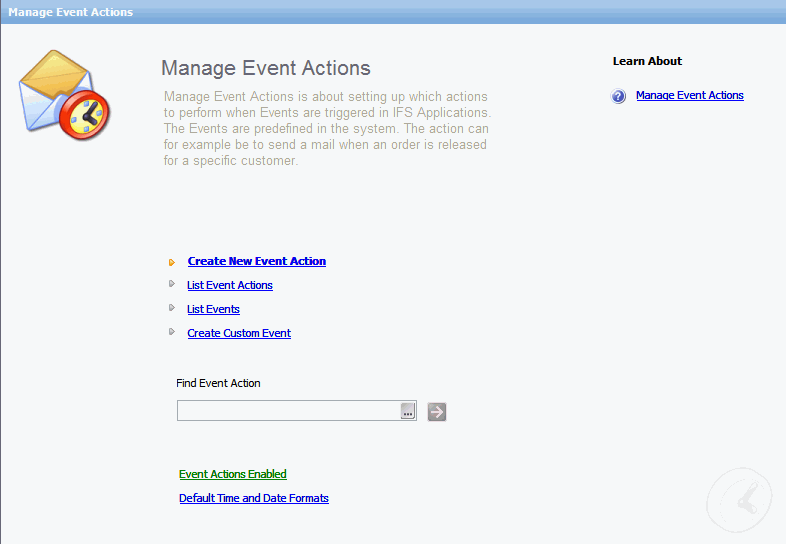
Manage Event Actions is about setting up which actions to perform when Events are triggered in IFS Applications. The Events are predefined in the system. The action can be for example to send a mail when an order is released for a specific customer.
Read more about concept
Events.
Structure of Contents below different from actual program window which can be misleading.
The Manage Event Actions form is the starting point when managing event actions. The most common tasks are available as short links on this page for example Create Event Action and List Event Actions.

From this start page you can easily find and navigate to existing Event Actions. Type the initial letters of the Event in Find Event Action followed by <Ctrl>-K. Once the Event Action is shown in the field press the navigate button to the right and the Event Action including detail information is shown in the Event Action form. If Event actions are enabled, which means that events are triggered and the actions are performed, the link Event Actions Enabled is shown, otherwise the link Event Actions Disabled is shown. Click on the link to turn the events on or off. To edit the default date and time formats for event actions click on the Default Time and Date Formats link and modify the format values in the dialog box.
New event Actions are created in the Event Action form. You can do that by simply clicking on Create New Event Action in the start page or in the start menu navigator in folder Solution Manager/Configuration/Event Actions or you can list the Event or Event Actions and right-click on one selected Event and invoke Create New Action for Event.
Action Type and Perform upon Event are mandatory. Besides that the Event Actions functionality must be turned on (this you can see in the Event Actions start page) and that IFS Connect must be configured to handle events each event action can be turned on and off. The event action must thus be enabled in order to be performed. When the Event action is enabled the Event is also enabled.
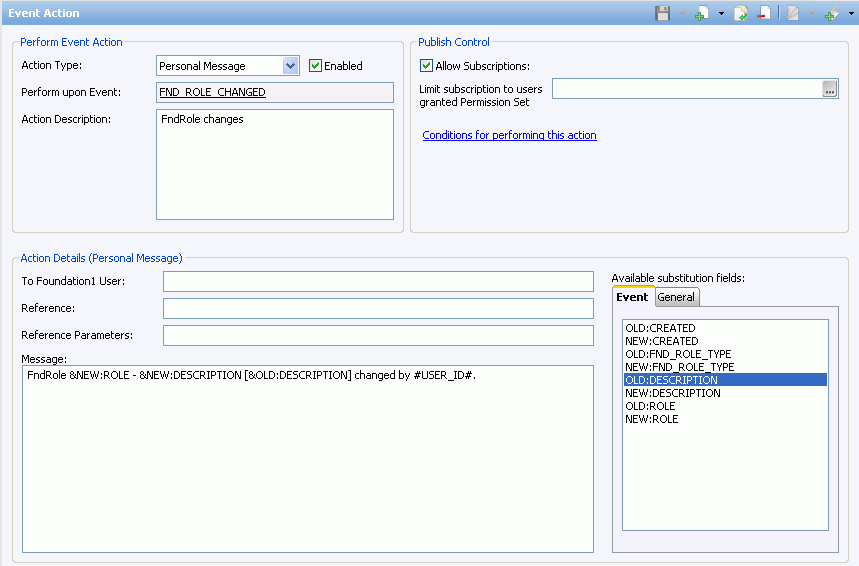
There are different kinds of actions that can be performed when an event is triggered. For each event you can set up several actions of different types. The action can be E-Mail, Shell Command, SMS-Message, Execute Online SQL, Personal Message or Application Message. These action types are described in the table below.
| Action | Description |
|---|---|
|
|
Send a mail to receiver. Event Registry's action email use method mail
in Parameters:
|
|
Shell Command |
Execute the statement submitted in the dialog as an OS
command line. Can be used to start program for example. Event Registry's
action Shell Command use method shell_command in Command_SYS
to send the command.
Parameters:
|
|
SMS-Message |
Sends an SMS-message to a GSM-client. Event Registry's action Socket
Message use method Parameters:
|
|
Execute Online SQL |
Execute the SQL-statement in the dialog. The statement will be executed
in the current database. The statement is executed online without involving
any executor of actions. Parameters:
|
|
Personal Message |
Save the message in the database as a personal message,
meaning that the information about what user owns the message is stored
together with the message. The message can be viewed at any time until it
is deleted. In order to get Personal Messages the Foundation1 user must
subscribe to the specific Personal Message. For more information read about
Subscriptions and Personal Messages in end user documentation. Foundation1
Heavy Cleanup handles removal. Foundation1 Setting Cleanup age limit
in days for read personal messages controls the lifetime. The message
is saved without involving any executor of actions, this makes Personal
Messages perfect for testing of event actions. Personal Messages are suitable
for viewing for example in a personal portlet.
Parameters:
|
|
Application Message |
Creates an Application Message that is sent to Connect.
All the information available in the Event is included in the message. No
formatting of a specific text is available here; it is all handled by Connect.
It is though possible to set Connector, Address Data, Envelope
and Transformer. If Connector is specified Address Data is
mandatory. If Connector is not specified the message will be routed by Connect.
This event action is not possible to subscribe to.
Parameters:
|
| Task |
Creates a Task to one or many users visible in IFS Enterprise Explorer.
Parameters:
|
| Start Workflow |
Calls an external web service. The intention is to be able to call a workflow engine that expose web services to start a new instance of a defined workflow. Parameters:
|
Allow Subscription indicates that this action is available for subscription by end users. You can limit the possibility to subscribe to the action by entering a required permission set. Only users that are granted this permission set can then subscribe to the event action.
If an end user subscribes to an action, this means that the action handler sends this action to the subscribers as well as to the original receiver, stated in the action itself. It is not necessary to state a specific receiver if the action is especially designed for subscription. Actions possible to subscribe to are E-Mail, SMS-Message and Personal Message.
To be able to control the execution of the action you can enter a number of conditions that must be fulfilled. The action is thus only performed if all conditions are met. Click Edit... to edit the condition for the event action.
To create an action that contains useful information about the event it is possible to enter substitution fields into the message or subject. There are two types of substitution fields, Event and General.
Each event supplies a number of substitution fields with valuable information about the specific event. Select the substitution field and drag it into the message and place it where appropriate. The substitution field will automatically get prefixed "&" to mark it as a substitution field that will be replaced by real data.
The application provides a list of general Context Substitution Variables. These are not related to the actual event but can be useful to include in the message. A context substitution field can for example be the current users email address. Select the substitution field and drag it into the message and place it where appropriate. The substitution field will automatically get a pre- and postfix "#" marker to mark it as a context substitution variable substitution field that will be replaced by real data.
For email event actions you can add one or more files as attachments. Click on the button next to the Attached Files field to open a dialog where you can type the full path to the files that should be included. You can also in this dialog select option "Create and include file" and enter the text directly in the file contents field.
Click on List Event Actions in folder Solution Manager/Configuration/Event Actions to see all the event actions.
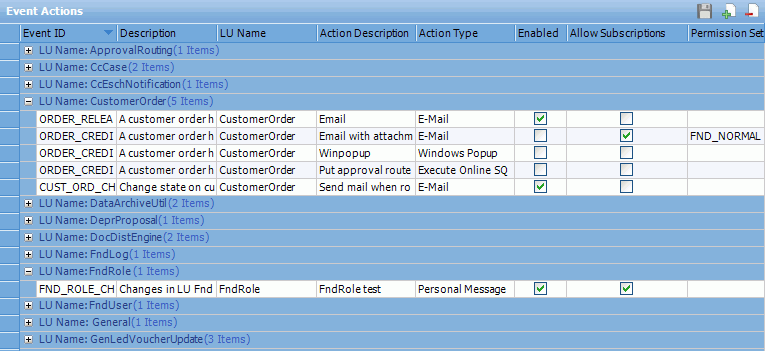
Click on List Events in folder Solution Manager/Configuration/Event Actions
to see all the events that is possible to create actions for.
The see the actions for an event right-click and select Show Actions. For
Custom Defined Events you can also select
Show Details in the same menu to view/edit the event.
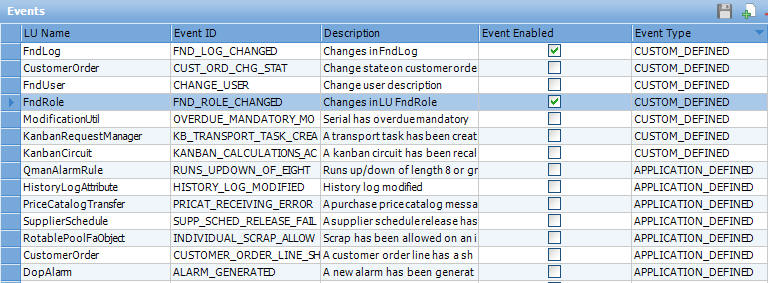
Custom Defined Events are events that are defined in a specific installation. The difference between Custom Defined Events and Application Defined Events is that Application Defined Events is defined in the code by the programmer meanwhile Custom Defined Events is configured and executed by triggers. The triggers is only created when the event is enabled, in order to recreate the triggers you need to disable the event and then enable it again.
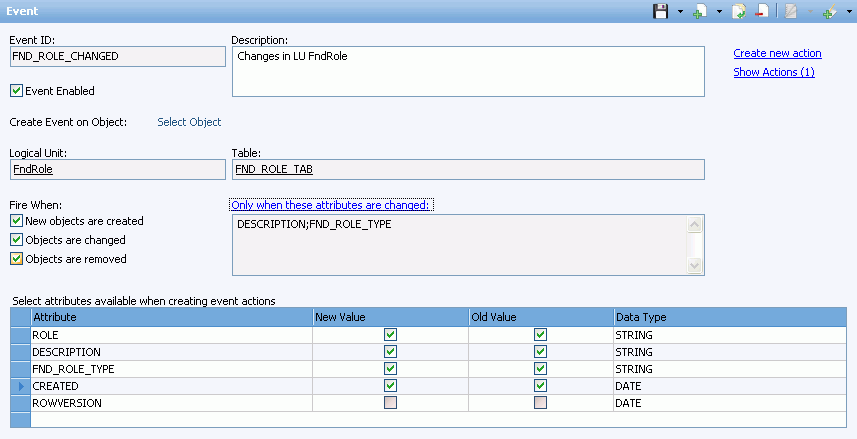
When you create a Custom Defined Event you select a Table on a Logical Unit that should handle the event. The event can be fired on three different occasions; New, Update and Remove.
Almost all attributes in the table are available to use in the Event Action
message. The only exceptions are LOB's and other special data types. In the attribute
list select which attributes that should be available when creating event actions
by checking the New Value and
Old Value. This creates variables called
NEW:<AttibuteName> for New Value
and OLD:<AttributeName> for Old Value,
for example "DESCRIPTION" and "NEW:DESCRIPTION" or "OLD:DESCRIPTION".
When the event is fired due to an object has changed the NEW:<AttibuteName>
is the variable for the new value after the transaction has occurred and OLD:<AttributeName>
is the variable for the old value before the transaction did take place. This is
how the variables get their value when event is firing:
NEW:<AttibuteName> and OLD:<AttributeName>
is the same value since no old values exists.NEW:<AttibuteName> is the new value after the transaction
and OLD:<AttributeName> is the old value before the transaction.NEW:<AttibuteName> and OLD:<AttributeName>
is the same value since no new value exists.A Custom Defined Event can have Custom Defined Attributes. To enter a new attribute
right-click in the list of Custom Attributes and select
Insert. Enter a name for the parameter and
a PL/SQL function <Package name>.<Method>. The PL/SQL function can
use Attributes described above as arguments.
Note: It is not possible to use Context Substitution Variables
as arguments to Custom Attributes.
Fnd_User_API.Get_Description(#USER_ID#) is not allowed.
Example:
Fnd_Role_API.Get_Description(&NEW:ROLE)orFnd_Role_API.Get_Description(&OLD:ROLE)
Note: If a Custom Defined Parameter selects from the Custom
Defined Events table you will run into Oracle error 4091.
ORA-04091: table SCOTT.Emp_tab is mutating, trigger/function may not see it
A Custom Defined Event can be exported to the file system as a (*.ins) file. Right-Click in the Custom Defined Event detail form to open the context menu and select Export Custom Event. Set a filename for the export file and click on save to save the file. The Event can then be imported into another environment by executing the export file in the database.